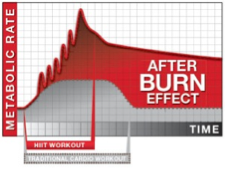By Kelly Scott
If these are your fitness goals, this article is for you:
- Burn fat
- Improve muscle tone
- Build endurance
- Increase energy
- Reduce risk of heart disease
- Normalize blood-pressure
- To age gracefully
If these are your fitness challenges, this article is for you:
- Time constraints
- Lack of motivation
- Impatience
- Boredom with exercise
- Appetite control
- Lack of results with current routine
High Intensity Interval Training provides an exciting solution when compared to the most common style of exercise: Traditional Cardio.
Cardiovascular exercises have been traditionally known to help in weight loss and improve the overall well being of a person. With that being said, not everyone has the time to dedicate 40 to 90 minutes per day, 4 to 6 days a week to cardio in today’s busy world.
Generally, cardiovascular exercises tend to show diminishing results over a period of time, which can be another challenge for people who are frustrated by their weight. Additionally, excessive endurance exercise can compromise your metabolism by breaking-down hard earned muscle tissue and releasing hormones that make your body prone to store more fat.
High Intensity Interval Training (HIIT) on the other hand, provides quick, but not instant, results in terms of weight loss and toning the body. Though traditional cardiovascular exercise remains an effective type of training in the right amounts, HIIT can offer outstanding results without taking too much time from your schedule or sacrificing your metabolism, bones, muscles or joints.
Traditional Cardio (CMT)
Let’s start by defining what I label as “traditional cardio.” Traditional Cardio is long duration activity that can stimulate your cardiovascular and respiratory system over a period of time. It’s also called continuous moderate-intensity exercise (CMT). In other words, it relates to exercises that are performed at a moderate intensity for at least 30 minutes to over an hour. Generally, people refer to this as “aerobic exercise.” Aerobic exercise burns calories, helps with lowering your cholesterol, and will provide you with overall health benefits. It increases the breathing capacity in a person and helps build endurance.
Common examples of aerobic exercise or CMT include jogging, swimming, cycling, elliptical machines, dance workouts, and step aerobics. CMT combined with strength training exercises can go a long way in helping you achieve a toned and muscular physique. This traditional exercise program would require at least one hour per day, four to five days per week of CMT, and an additional one hour of strength training, two to three days per week.
Total weekly exercise time: six to eight hours per week.
High Intensity Interval Training (HIIT)
HIIT on the other hand is quite different from traditional cardio. HIIT requires you to dedicate 15 to 30 minutes of your time, and is viewed as a convenient option by many men, women, and even senior citizens. HIIT is basically performing an activity at high intensity for a specific time (referred to as the work interval) and then performing an activity at very low intensity (referred to as the recovery interval). This routine is continued until the targeted time is complete.
Research shows that HIIT can provide the same overall health benefits of longer duration cardio, and that it is far more effective for fat loss. An effective exercise program combining HIIT with strength training would require at least 15 minutes a day, two to three days a week of HIIT, and an additional 45 minutes of strength training, two to three days a week.
Total weekly exercise time: two to three hours per week.
11 Research-Backed Reasons You Should Be Doing HIIT Instead of Traditional Cardio
1.) It’s great for busy people
HIIT stimulates similar or better physical improvements than moderate-intensity continuous training (CMT). The total time commitment required to achieve ideal fitness levels is substantially lower than traditional methods. This is great news, given that “lack of time remains the most commonly cited barrier to regular exercise participation,” states M. J. Gibala, Department of Kinesiology, McMaster University.1
2.) It’s very effective for fat loss (especially abdominal fat)
A study published in American Journal of Physical Medicine and Rehabilitation cited 62 overweight and obese subjects who performed HIIT with strength training two to three times per week over nine months and saw significant improvement in both waist circumference measurements and overall body fat. In contrast, longer exercise sessions exceeding 60 minutes stimulates over production of stress hormones, like cortisol. High levels of cortisol contributes to the storage of abdominal fat. 2 6
3.) It stimulates powerful anti-aging hormones
HIIT has been shown to stimulate the production of human growth hormone (HGH). HGH slows down aging by increasing exercise capacity, increasing bone density, increasing muscle mass, and decreasing body fat. In contrast, overdoing long bouts of traditional cardio can actually damage your mitochondria and accelerate aging.3
4.) It builds endurance faster
With HIIT, maximal exercise capacity (endurance) is increased in a very short time. It has been shown to improve VO2 max (a marker of aerobic fitness) faster then long duration cardio.3 4
5.) It’s superior in preventing and controlling high blood pressure
A study published by the American Journal of Cardiovascular Disease showed women at high risk for hypertension saw greater improvements to blood pressure after just 16 weeks of HIIT, compared to the group that performed 16 weeks of CMT training. Improvements to insulin sensitivity, stiff arteries, and cardiorespiratory fitness were superior among the HIIT group. 5
6.) It reduces risk of diabetes, heart disease, or stroke
It’s well known that traditional cardio produces these benefits, but research proves that if you are overweight or obese you can still reduce your cardiometabolic risk with HIIT. This means you can still get the life-saving benefits of cardio without a large time commitment. 2
7.) It suppresses your appetite
In a study on the effects HIIT on fat loss, Australian researchers cited a lower perceived appetite after HIIT training. Other researchers suggest this is partly due to release of an satiety hormone called peptide YY, as well as lowered levels of an appetite stimulant, ghrelin, after high intensity work. It gets even better because HIIT works best when paired with a progressive strength training program. Studies suggest that strength training has also been proven to release gut hormones that regulate appetite during and after exercise. 8 9
8.) You’ll see results faster
So fast that previously untrained people saw an improvement in endurance, muscle tone and performance in as little as six HIIT sessions. That’s fast! 10
9.) It boosts your metabolism
Another benefit of HIIT is excess post exercise oxygen consumption (EPOC). This means that after you complete your workout, your oxygen consumption and calorie burning remain elevated for up to 48 hours. This higher metabolic level continues as your muscle cells are repaired and restored. 12
10.) It helps you lose fat while preserving muscle
A common frustration among dieters and weight-loser/gainers is that they gain all the weight back – and more! This is because cutting calories and excessive traditional cardio (CMT) seems to encourage muscle loss. Loss of lean, metabolically active muscle tissue results in a decreased metabolism, which makes the fat come right back. Fortunately, strength training and HIIT allow you to preserve your precious muscle tissue and push your metabolism in overdrive. 10
11.) It’s great for people with a short attention span
Boredom is one of the top three reasons why people stop exercising. Not only are HIIT workouts too short to let your mind wander, but HIIT workouts don’t offer you the luxury of getting bored. This is because when you’re not pushing it hard – real hard – you’re busy sucking wind trying to catch your breath before the next interval. Getting bored with a HIIT workout would be like getting bored while running to save your life if a bear was chasing you. 11
Sample HIIT Routines:
You don’t need any fancy equipment. Just some motivation and a great warmup. Here are some examples:
- 30-60 seconds of sprinting, and then walking at a brisk pace for two minutes until the routine is complete.
- 30 seconds of kettlebell swings paired with walking at a slow pace until your breathing normally. Repeat for 10-15 minutes.
- Climbing up 100 stairs quickly, and then walking down at normal pace until the routine is complete.
Ready to hit a HIIT workout?
To put it all in perspective, Traditional Cardio and HIIT are both effective at improving the health of a person. While traditional cardio has its benefits in a well rounded workout program, it might not be the best standalone choice for you. In fact, arbitrarily doing more exercise could hinder you from reaching your goals. Better results could be attained though implementing a HIIT/progressive strength focused program with incidental cardio. Based on your needs and how much time you can dedicate to promoting your health, HIIT training could make a positive impact on the results you’re getting. If you believe you can dedicate two to three days a week (depending on your fitness goals) to high intensity training, then go for HIIT without thinking twice.
Many of our clients are in awe at the results they achieve in just three sessions a week. You will be too.
So what are you waiting for? Let’s HIIT it!
ForeverStrong Fitness System™ combines progressive strength training with HIIT finishers. Based on our research, the best results come from the most effective exercise programming.
If you or someone you know would benefit from personalized exercise programming, contact us to schedule a complimentary fitness consultation.
REFERENCES:
1 M. J. Gibala et al. Physiological adaptations to low-volume, high-intensity interval training in health and disease. March 1, 2012 The Journal of Physiology, 590, 1077-1084
2 Gremeaux V et al. Long-term lifestyle intervention with optimized high-intensity interval training improves body composition, cardiometabolic risk, and exercise parameters in patients with abdominal obesity. American Journal of Physical Medicine and Rehabilitation 2012 Nov; 91(11): 941-59
3 Stokes KA et al. The time course of the human growth hormone response to a 6 s and a 30 s cycle ergometer sprint. J Sports Sci. 2002 Jun;20(6):487-94.
4 Helgerud J, Hoydal K, Wang E, et al. Aerobic high-intensity intervals improve VO2max more than moderate training. Med Sci Sports Exerc 2007;39:665–71.
5 Ciolac EG. High-intensity interval training and hypertension: maximizing the benefits of exercise? American Journal of Cardiovascular Disease 2012; 2(2): 102-10
6 Moyer AE et al, Stress-induced cortisol response and fat distribution in women. Obes Res. 1994 May;2(3):255-62.
7 Shiraev T, Barclay G. Evidence based exercise—clinical benefits of high intensity interval training. Australian Family Physician 2012 Dec; 41(12): 960-62
8 Boutcher SH. High-intensity intermittent exercise and fat loss. J Obes. 2011;2011:868305. doi: 10.1155/2011/868305. Epub 2010 Nov 24.
9 Broom et al. The influence of resistance and aerobic exercise on hunger, circulating levels of acylated ghrelin and peptide YY in healthy males. AJP Regulatory Integrative and Comparative Physiology, 2008; DOI:10.1152/ajpregu.90706.2008
10 Robert Acton Jacobs et al. Improvements in exercise performance with high-intensity interval training coincide with an increase in skeletal muscle mitochondrial content and function. Journal of Applied PhysiologyPublished 15 September 2013Vol. 115no. 785-793
11 David G. Marrero, PhD. Time to Get Moving: Helping Patients With Diabetes Adopt Exercise as Part of a Healthy Lifestyle. Clinical Diabetes October 2005 vol. 23 no. 4 154-159
12 Christopher G.R. Perry, George J.F. Heigenhauser, Arend Bonen, et al. High-intensity aerobic interval training increases fat and carbohydrate metabolic capacities in human skeletal muscle. Applied Physiology, Nutrition, and Metabolism. NRC Research Press. Dec 1, 2008
